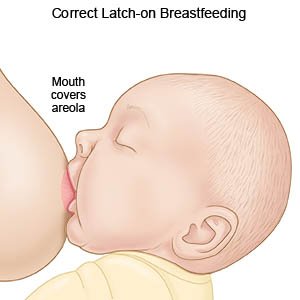Breastfeeding and Breast Implants
Medically reviewed by Drugs.com. Last updated on May 6, 2024.
You may be able to breastfeed if you have breast implants. It depends on the type of implants, the placement of the implants, and the way the surgery was done. You may worry that chemicals in your breast implants will mix with breast milk. Some breast implants are filled with saline water. Healthcare providers see no harmful effect if saline water mixes with breast milk. Some breast implants contain a chemical called silicone. Some healthcare providers say it is okay to breastfeed if you have silicone implants. Tell your healthcare provider if you have silicone implants and ask him or her if you should breastfeed.
DISCHARGE INSTRUCTIONS:
Contact your healthcare provider if:
- Your milk has not come in within 5 days of giving birth.
- Your baby is 4 or more days old and has fewer than 6 wet diapers each day.
- Your baby is 4 or more days old and has fewer than 3 bowel movements each day.
- Your baby is breastfeeding fewer than 8 times each day.
- You feel you are not making enough breast milk for your baby.
- You have nipple pain while breastfeeding, or between feedings.
- You have questions or concerns about breastfeeding.
Breastfeeding problems after breast implant surgery:
Nerves, milk ducts, and milk glands can be damaged during implant surgery. Injured nerves can decrease the feeling in your nipple area. This may reduce your let-down response. This is when milk is released from the glands to the milk ducts so that it is available to your baby. Damaged milk ducts can decrease the amount of milk made by your breasts. Implants can also pinch milk ducts, block the flow of breast milk, and make your breasts swell.
How the types of breast implant surgeries affect breastfeeding:
- The type of incision made during surgery can affect breastfeeding. An incision made around or across your areola (dark circle around the nipple) can damage the nerves. Incisions may instead be made under the breast, in the armpit, or in the belly button. These types of incisions are less likely to damage milk ducts, glands, or nerves.
- The area where your implants are placed may also affect your ability to breastfeed. Breast implants can be placed in between your breast tissue and chest muscle. They also can be placed under the chest muscle to prevent damage to milk ducts and nerves. Implants placed under the chest muscle will not cause silicone to go into your breast milk. Incisions may be made through fatty tissue under your breast tissue to put the implants in place. This method is less likely to damage breast tissue.
How to help your baby latch on correctly:
Help your baby move his or her head to reach your breast. Hold the nape of his or her neck to help him or her latch onto your breast. Touch his or her top lip with your nipple and wait for him or her to open his or her mouth wide. Your baby's lower lip and chin should touch the areola (dark area around the nipple) first. Help him or her get as much of the areola in his or her mouth as possible. You should feel as if your baby will not separate from your breast easily. A correct latch helps your baby get the right amount of milk at each feeding. Allow your baby to breastfeed for as long as he or she is able.
 |
Signs your baby is latched on correctly:
- You can hear your baby swallow.
- Your baby is relaxed and takes slow, deep mouthfuls.
- Your breast or nipple does not hurt during breastfeeding.
- Your baby is able to suckle milk right away after he or she latches on.
- Your nipple is the same shape when your baby is done breastfeeding.
- Your breast is smooth, with no wrinkles or dimples where your baby is latched on.
How to tell if your baby is getting enough breast milk:
Your baby is getting enough breast milk if he or she has 6 to 8 wet diapers and 3 to 4 bowel movements each day. Also, your baby is getting enough milk if he or she is gaining weight and breastfeeds 8 to 12 times each day. Ask your healthcare provider for more information on how to tell if your baby is getting enough breast milk.
How to increase your milk supply:
Use a breast pump after each feeding to help stimulate your breasts to make more milk. The breast pump also helps you empty each of your breasts completely. Breast massage also may help stimulate your breasts and increase your milk supply. Feed your baby 8 to 12 times each day to increase your milk supply. Ask your healthcare provider for more information on how to increase your milk supply.
Follow up with your doctor as directed:
Write down your questions so you remember to ask them during your visits.
For support and more information:
- American Academy of Pediatrics
345 Park Boulevard
Itasca , IL 60143
Phone: 1- 800 - 433-9016
Web Address: http://www.aap.org
- La Leche League International
957 North Plum Grove Road
Schaumburg , IL 60173
Phone: 1- 847 - 519-7730
Phone: 1- 800 - 525-3243
Web Address: http://www.lalecheleague.org
© Copyright Merative 2024 Information is for End User's use only and may not be sold, redistributed or otherwise used for commercial purposes.
The above information is an educational aid only. It is not intended as medical advice for individual conditions or treatments. Talk to your doctor, nurse or pharmacist before following any medical regimen to see if it is safe and effective for you.
Further information
Always consult your healthcare provider to ensure the information displayed on this page applies to your personal circumstances.
